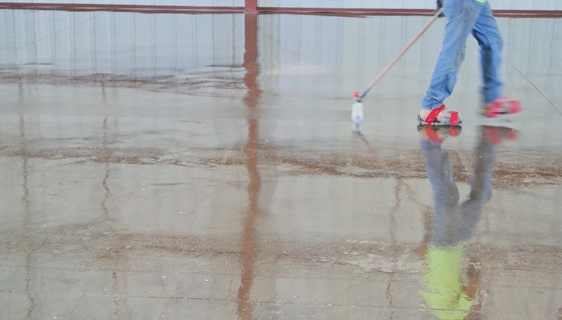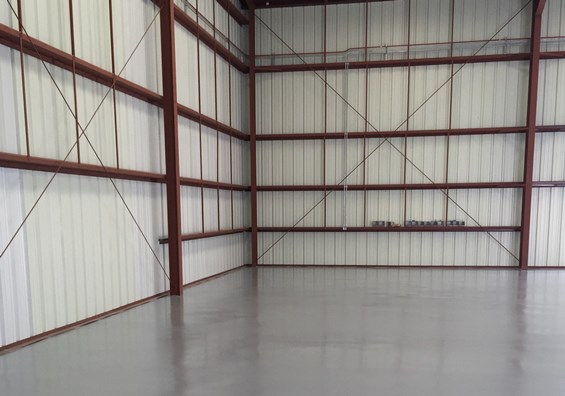A hot summer, a poor concrete pour, and a building with no electricity. This could have added up to the makings of a failed mission, but with an experienced crew from Industrial Flooring Specialists (IFS) and adaptable materials, the new epoxy floor at a naval base in Jacksonville, Florida, didn’t go awry. In fact, the folly was made fantastic in only five days.
On-Shore Breaks
The success of the surplus building floor started when the five-person crew arrived on site. The situation was critical: the deck was not up to snuff. “We started the building and the concrete was brand new, but the concrete was very suspect,” Technical Director Pat Sicilia said. “It had a lot of cracks in it; the cap was not in good shape.”
Sicilia worked as a contractor in New England for 19 years before moving to Florida so he’s seen his fair share of good and bad concrete down the coast. “I have seen many, many slabs in the south here that were not poured like the north,” he explained. And “concrete design is very important when we’re doing coatings,” which meant that their first task was to fix the 5,000-square-foot (464.5 m²) floor.
First, they worked to achieve Society for Protective Coatings (SSPC) Surface Preparation (SP) 3: Power Tool Cleaning. “A heavy sand paper finish is what we want,” Sicilia said. “And once you have that you have good bonding of the primer and the damn thing won’t come off. It’s usually the goal.” The crew used a Blastrac 1-15DSGI with 230 shot to start followed by a Pioneer Eclipse Mongrel and Metabo hand grinders to the floor and edges.
“When you’re doing coating systems like this, you have to brush blast it with smaller shot but you need to create a profile that gives you the ability to anchor the profile and not create any irregular overlap lines from the shot blast machines. You’ve got to be a very skilled technician to run the machines in that order,” Sicilia explained.
Any joints or cracks were filled with a flexible epoxy called PlexiPatch QC, and then a flood coat was applied. According to Sicilia, the flood coat “conditions the surface of the concrete” and “creates the bonding ability for all the layers.” That coating was PlexiGlaze #4, a clear epoxy, which was laid down at 7 to 10 mils (177.8‒254.0 microns). Next were the primer and intermediate coat, each PlexiGlaze IFF (Industrial Floor Finish) applied at 10 to 15 mils (254.0‒381.0 microns). Those were followed by the pigmented urethane topcoat, PlexiCrest P, applied at 3‒5 mils (76.2‒127.0 microns).
They applied each coat with squeegees, which were notched to help them get the right coverage with the 100-percent solids materials. Each crew member also carried around a wet film thickness gage. “But the guys have been doing these for so long sometimes they don’t have to [measure] because technicians have the ability to get what they need,” Sicilia said. It’s “inherent and there’s skill.”

Another standard for each layer of the floor was to sand and vacuum before moving onto the next layer. The crew used Ruwac equipment for the latter. And because the building didn’t have electricity yet, they used generators to work the equipment.
To the Battle Stations!
Florida summers are hot, and the building started with no doors and no air conditioning. Temperatures hit 95 °F (35.0 °C), which meant that the crew was constantly battling the heat. To help the coatings, the crew used 48-inch (121.9 cm) fans and adjusted the coating mix.
As Sicilia explained, “It’s the hardeners that give you the ability to regulate and change the workability, the dynamics of speed, the cure speed, and many other factors that go along with different types of chemistries in the epoxy world.” He continued, “So what we do is change and regulate the speed of cure by alternating and addressing the chemistry of the products themselves to slow it down. We have materials that we can use even in 100-degree [37.8 °C] weather.”
The crew also used the building doors toward the end of the project — once they were installed. Because the epoxy isn’t ultraviolet (UV) stable, they kept the doors nearly closed for light protection but not shut all the way so they could avoid damaging the curing coatings. “Sometimes when the sun is beating on epoxy it will create all kinds of bubbles because it’ll cook it. It’s just like cooking an egg,” Sicilia explained. “When you put sun directly on epoxy it creates all types of problems.”
The crew needed to keep the doors down for the urethane for a different reason. “When you’re putting the urethane down, you have to be careful not to create too much ventilation because that will start desiccating or drying the urethane. And if you do that you can’t roll it out; it leaves roller marks and whatnot,” he explained.
The crew members also needed help with the heat, especially because everyone had to wear long pants throughout the job. Overheating was a concern. To stay hydrated, they drank water and Gatorade. “I buy pallets of Gatorade and water from Costco,” Sicilia said. “You gotta have it.”
The crew members also wore safety boots, gloves, hats, and glasses at all times; dust masks when prepping; and respirators by 3M when applying the urethane. Each crew member carried his or her own personal protective equipment (PPE) in a “safety protection bag,” according to Sicilia.
IFS was also sure to train the crew, particularly concerning the Occupational Safety and Health Administration’s (OSHA’s) new regulations for silica dust, Sicilia said. “We have new trainings going on; people have to be much more aware than ever before when they’re grinding and anything like that,” he said.
Value Add
Despite the heat and other challenges, Sicilia chalked the success of this project up to the fact that he had a great crew and materials that work. “We have good solid crews that we work with. In most cases, our projects get specified and they ask for the same crews over and over again because they do such a good job in the field,” he surmised.
At the end of the day, the important thing was to keep the client’s needs in mind. “We give them good value. They invest their money and the important thing is not to have to go back,” Sicilia continued. On this floor, there was no punch list, so when the urethane went down and the crew cleaned up, they were able to ship out. Another successful mission in the books!
